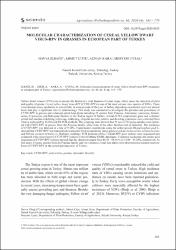| dc.contributor.author | İlbağı, Havva | |
| dc.contributor.author | Çıtır, Ahmet | |
| dc.contributor.author | Kara, Adnan | |
| dc.contributor.author | Uysal, Mücteba | |
| dc.date.accessioned | 2022-05-11T14:43:36Z | |
| dc.date.available | 2022-05-11T14:43:36Z | |
| dc.date.issued | 2020 | |
| dc.identifier.issn | 0551-3677 | |
| dc.identifier.uri | https://doi.org/10.2478/agri-2020-0015 | |
| dc.identifier.uri | https://hdl.handle.net/20.500.11776/9662 | |
| dc.description.abstract | Yellow dwarf viruses (YDVs) are economically destructive viral diseases of cereal crops, which cause the reduction of yield and quality of grains. Cereal yellow dwarf virus-RPV (CYDV-RPV) is one of the most serious virus species of YDVs. These virus diseases cause epidemics in cereal fields in some periods of the year in Turkey depending on potential reservoir natural hosts that play a significant role in epidemiology. This study was conducted to investigate the presence and prevalence of CYDV-RPV in grasses and volunteer cereal host plants including 33 species from Poaceae, Asteraceae, Juncaceae, Geraniaceae, Cyperaceae, and Rubiaceae families in the Trakya region of Turkey. A total of 584 symptomatic grass and volunteer cereal leaf samples exhibiting yellowing, reddening, irregular necrotic patches and dwarfing symptoms were collected from Trakya and tested by ELISA and RT-PCR methods. The screening tests showed that 55 out of 584 grass samples were infected with CYDV-RPV in grasses from the Poaceae family, while none of the other families had no infection. The incidence of CYDV-RPV was detected at a rate of 9.42%. Transmission experiments using the aphid species Rhopalosiphum padi L. showed that CYDV-RPV was transmitted persistently from symptomatic intact grasses such as Avena sterilis, Lolium perenne and Phleum exratum to barley cv. Barbaros seedlings. PCR products of five Turkish RPV grass isolates were sequenced and compared with eleven known CYDV-RPV isolates in the GenBank/EMBL databases. Compared nucleotide and amino acid sequences of CYDV-RPV isolates showed that the identities ranged from 40.38 - 95.86 % to 14.04 - 93.38%, respectively. In this study, 19 grass species from the Poaceae family and two volunteer cereal host plants were determined as natural reservoir hosts of CYDV-RPV in the cereal growing areas of Turkey. © 2020 Authors. | en_US |
| dc.language.iso | eng | en_US |
| dc.publisher | De Gruyter Open Ltd | en_US |
| dc.identifier.doi | 10.2478/agri-2020-0015 | |
| dc.rights | info:eu-repo/semantics/openAccess | en_US |
| dc.subject | CYDV-RPV | en_US |
| dc.subject | Grasses | en_US |
| dc.subject | Molecular diversity | en_US |
| dc.subject | Polerovirus | en_US |
| dc.subject | aphid | en_US |
| dc.subject | barley | en_US |
| dc.subject | crop yield | en_US |
| dc.subject | epidemic | en_US |
| dc.subject | epidemiology | en_US |
| dc.subject | grass | en_US |
| dc.subject | host plant | en_US |
| dc.subject | seedling | en_US |
| dc.subject | symptom | en_US |
| dc.subject | virus | en_US |
| dc.subject | Turkey | en_US |
| dc.subject | Asteraceae | en_US |
| dc.subject | Avena sterilis | en_US |
| dc.subject | Cereal yellow dwarf virus - RPV | en_US |
| dc.subject | Cyperaceae | en_US |
| dc.subject | Geraniaceae | en_US |
| dc.subject | Hordeum | en_US |
| dc.subject | Juncaceae | en_US |
| dc.subject | Lolium perenne | en_US |
| dc.subject | Meleagris gallopavo | en_US |
| dc.subject | Phleum | en_US |
| dc.subject | Poaceae | en_US |
| dc.subject | Polerovirus | en_US |
| dc.subject | Rhopalosiphum padi | en_US |
| dc.subject | Rubiaceae | en_US |
| dc.title | Molecular characterization of cereal yellow dwarf virus-RPV in grasses in European part of Turkey | en_US |
| dc.type | article | en_US |
| dc.relation.ispartof | Agriculture | en_US |
| dc.department | Fakülteler, Ziraat Fakültesi, Bitki Koruma Bölümü | en_US |
| dc.identifier.volume | 66 | en_US |
| dc.identifier.issue | 4 | en_US |
| dc.identifier.startpage | 161 | en_US |
| dc.identifier.endpage | 170 | en_US |
| dc.institutionauthor | İlbağı, Havva | |
| dc.institutionauthor | Çıtır, Ahmet | |
| dc.institutionauthor | Kara, A. | |
| dc.relation.publicationcategory | Makale - Uluslararası Hakemli Dergi - Kurum Öğretim Elemanı | en_US |
| dc.authorscopusid | 8869167100 | |
| dc.authorscopusid | 8869166900 | |
| dc.authorscopusid | 57209209003 | |
| dc.authorscopusid | 57209216001 | |
| dc.identifier.scopus | 2-s2.0-85101602513 | en_US |



















